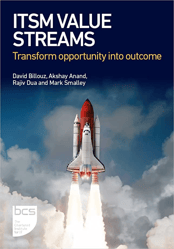In this post, our second in a series where we’ll investigate the treatment of value stream management (VSM) in the context of industry frameworks, Akshay Anand has a look at ITIL4.
ITIL (and no it’s not the “IT Infrastructure Library”; it hasn’t been an acronym for over 10 years!) released its latest major revision - dubbed ITIL 4 - in February 2019. The updates aimed not only to provide best practice guidance for modern IT/SM teams, but also to highlight how ITSM professionals could work alongside Agile, DevOps, and Lean IT teams (as well as teams following other frameworks). It did so by introducing several new concepts and updating many established ones, thereby highlighting the importance of topics such as:
- the “co-creation” of value over the “delivery” of value (and not just value for the “end-user”)
- “Practice-centric” thinking over “process-centric” thinking
- IT Governance and Guiding Principles
- Service Value Streams (which is what we’ll be exploring in this blog!)
Service Value Streams in ITIL 4 were first introduced in the ITIL 4 Foundation publication and were subsequently expanded upon in the ITIL 4 Create Deliver and Support publication. This blog post will cover some of the key points about value streams in ITIL 4, but for more detail please refer to the official publications.
While Lean techniques can be applied to analyze service value streams to calculate wait and cycle time, identify bottlenecks, and identify waste, ITIL 4 describes value streams as a way to also design, train and communicate the steps required to convert demand to value. Specifically:
- A Service Value Stream is mapped to an organization. ITIL 4 defines an organization as a person or group of people that has its own functions with responsibilities, authorities, and relationships to achieve its objectives. In other words, an “organization” is not the same as a legal entity - the definition scales from a “one-person team” to a “multinational corporation”! A single developer managing a microservice can define their value streams; scaling up, a team or a department or a business unit, or a corporate entity can have its own value streams. An “organization” might have multiple value streams based on how varied its work is.
- A Service Value Stream must connect demand to value. Best practice bodies of knowledge rarely deal in absolutes, and this is one example - in ITIL 4, a service value stream must start as the result of some form of demand and must result in the co-creation of value. If it doesn’t then chances are the level of granularity is wrong. To take the earlier example, the single developer might define certain types of demand and value (e.g. a “request for a new feature” and “feature live in production”) differently from how a business unit might define the same (e.g. “expand into a new market” and “newly opened stores in target locations”). A step in the middle of the developer’s value stream might be “Collect feedback” - this could be a value stream itself, perhaps for another organization.
- A Service Value Stream depicts the flow of work, information, and value across multiple types of activity. There are 6 activity archetypes (these form part of a model called the Service Value Chain): Engage, Plan, Design & Transition, Obtain/ Build, Deliver & Support, and Improve. A value stream can be either “waterfall” or iterative in its construction - for example, once an investment decision is made (Plan step), it is never revisited; the value stream could define multiple Plan steps every time a major phase is completed (for example, after an update has been released, or after improvement opportunities are identified and prioritized.
- A value stream draws upon an organization's practices (or capabilities) to provide it with the people, skills, information, technology, relationships (e.g. with partners & suppliers), and processes to complete each step. It is important to keep in mind that a practice (or capability) is not the same as a “team” - it represents the ability to fulfill the purpose of that practice - for example, the IT Support, IT Operations, and Software Development teams could all be part of the Incident Management practice. Let’s take a value stream to develop and release a new service feature, and consider two distinct steps:
- A step to make a go/no-go investment decision might call upon organizational practices (capabilities) such as Service Financial Management, Strategy Management, Architecture Management, Capacity and Performance Management, and Risk Management.
- A step to refine a backlog as part of a value stream to develop and release a new service feature might call upon practices such as Business Analysis, Service Design, Architecture Management, Continual Improvement, Knowledge Management, and many others besides.
So, putting it all together: in ITIL 4, organizations can document their responses to commonly encountered types of demand by defining a service value stream; the value stream is a depiction of the various steps that the organization takes to co-create value; steps in the value stream describe what type of activity primarily occurs in the step, and what organizational practices (or “capabilities”) contribute to the step.
I think a key point I would like to close this blog post on is that value streams (when defined in this way) are not just for Agile and DevOps teams, or not just for ITSM teams, or just for a specific part of a modern organization. They represent universally applicable concepts and models that can be used to join up work across an organization, helping break down silos, and improve collaboration and cooperation between different teams!
If you want to go further on the subject, an upcoming book entitled “ITSM Value Streams” will be released on June 22, 2023.
ITSM Value Streams is a comprehensive guide to organizations on how to effectively utilize IT services to achieve business outcomes. This is an essential resource for people in IT service management, IT managers, IT service managers, and consultants and offers the chance to learn how to apply value stream thinking to achieve their IT service management objectives and also to get familiar with value management concepts.
ITSM Value Streams: Transform opportunity into outcome
by David Billouz, Akshay Anand, Rajiv Dua, and Mark Smalley.
Stay tuned, our next post in this series will investigate the treatment of VSM in the context of another industry framework: Joshua Barnes will have a look at Disciplined Agile.
If there is another framework you'd like to see covered, feel free to suggest it in the comments.
On the same subject, don't hesitate to consult our previous posts:
See also our research and learning from here:
ITIL® is a registered Trade Mark of Axelos Limited.
Picture credits: Shutterstock

Akshay Anand
Akshay Anand is a seasoned ITSM professional, with over 20 years of experience delivering projects and running service management teams. He was a Lead Architect & author for the ITIL 4 body of knowledge. He currently works as a Solutions Engineer at Atlassian promoting solutions based on Jira Service Management.








Comments 0